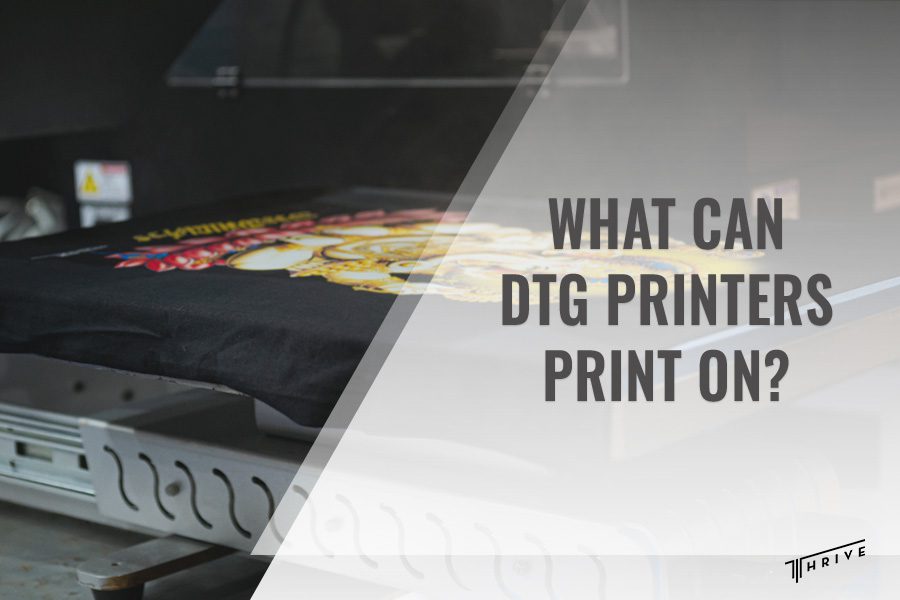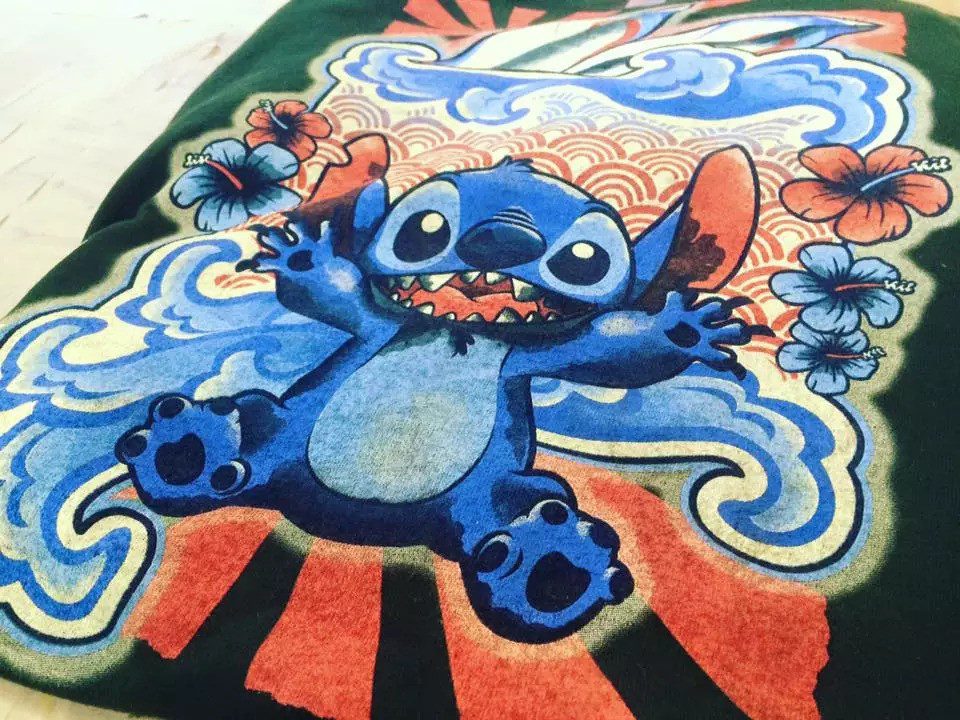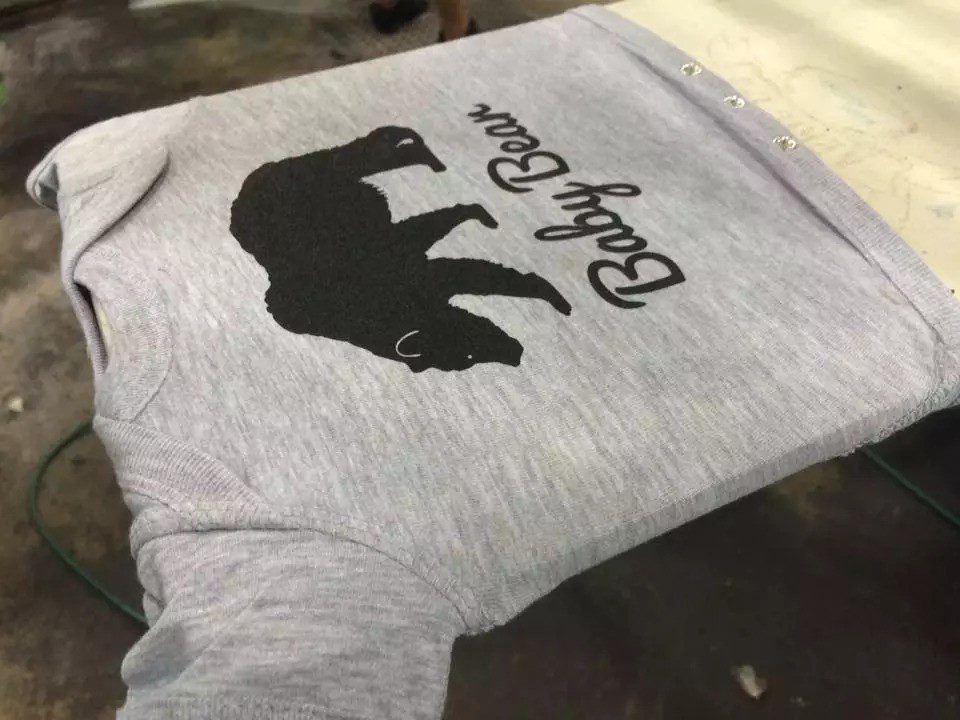
DTG, or direct-to-garment printers, are innovative inkjet machines that have revolutionized the custom printing world. They allow for high-quality, full-color printing on many textiles and fabrics. Now, we will explain what can DTG printers print on and see which is the best fabric for DTG printing.
Let’s dive in!
What Can DTG Printers Print On?
Our experience showed us that textiles and fabrics have always been popular for custom printing. Whether it is a T-shirt, hoodie, or tote bag, people love to add customized designs, logos, or graphics to their clothing.
DTG printers use inkjet technology to apply the desired design onto the fabric directly. Unlike screen printing, which requires separate screens for each color, DTG printers can achieve full-color printing in a single pass. This not only saves us time but also allows for more vibrant, detailed designs.
Since we provide contract screen and DTG printing services, we have a lot of experience with this technology and can easily answer which fabric is best for DTG printing.
Fabrics are the keystone of successful DTG printing. That is why we pay great attention to them. DTG printers are known for being versatile, yet not all fabrics are suitable for DTG printing. A DTG machine can print on different textiles and fabrics, like natural fabrics (cotton, linen, hemp, and bamboo), synthetic fabrics (polyester), and blends (cotton/polyester). DTG printers can produce vibrant prints on these surfaces with the right type of ink and pretreatment.

Top Choices Fabrics For DTG Printing
We recommend DTG printing for complex designs with many colors and details. DTG printers mostly use water-based inks, meaning they are best for natural fibers. These fibers quickly absorb water, allowing for the ink to adhere more easily to the fabric.
We have enlisted the most suitable printing materials for DTG printing.
Cotton
Cotton is one of the most widely used materials for clothing because of its softness, versatility, breathability, and affordability. Cotton is also a strong, high-quality material that easily absorbs water-based inks. Although there are many types of cotton, 100% cotton is the best material for DTG printing and the easiest to work with.
Regular cotton
Regular cotton is also known as non-organic or conventional cotton, and it is the most used type of cotton in the textile industry. It is grown using conventional farming techniques, including pesticides, fertilizers, and other chemicals.
Regular cotton is affordable and widely available. No wonder it is popular among manufacturers of fast fashion.
Organic cotton
Organic cotton, on the other hand, is grown using organic farming methods without the use of synthetic fertilizers and GMOs. It is grown using natural practices, like crop rotation, organic fertilizers, and biological pest control.
Organic cotton is known for its superior softness, purity, and sustainability. It is more expensive than regular cotton because of the high production costs related to organic farming practices. We recommend organic cotton to those who want to wear eco-friendly clothes or have sensitive skin. Organic cotton is considered one of the most eco-friendly options for DTG printing.
Ring-spun cotton
Ring-spun cotton refers to a special spinning process used to create yarn. It involves twisting and thinning the cotton fibers to produce a string and smooth yarn. Ring-spun cotton fabrics are softer, lighter, and long-lasting. Ring-spun cotton is more comfortable to wear than regular cotton.
When it comes to DTG printing, ring-spun cotton is a great choice for detailed print designs and embroidery because it has a smoother, less porous surface with a ticker knit, ideal for prints. Ring-spun cotton clothes are more durable and less prone to pilling. We recommend rung-span cotton for fashion and “boutique” printing.
Combed cotton
Combed cotton undergoes an extra process called combing, which removes shorter fibers and impurities from the cotton strands. This process leads to a stronger, smoother, and more uniform yarn.
Combed cotton has a polished appearance and a comfortable feel. Combed cotton has longer and stronger fibers, ideal for everyday wear. That is why combed cotton is used for high-quality clothes like fine knitwear, premium T-shirts, and shirt dresses. DTG printing works well on combed cotton. The ink tends to bond well with this fabric, resulting in detailed and vibrant prints.
Linen
Linen is a natural fabric made from the fibers of the flax plant. It is known for its coolness, breathability, and ability to absorb. Linen has a unique texture and a slightly rough feel. It is highly durable and gets softer and more comfortable with each wash.
Linen garments provide great ventilation, and it is a great material for summer and casual wear. It is usually used for shirts, dresses, and pants. When it comes to DTG printing, the ink may not be as compatible as with cotton since linen has a rough surface. This means that linen’s texture causes variations in print quality, resulting in less vibrant prints than those on cotton.
Hemp
Hemp is a highly absorbent material, which allows vibrant printing results. The fabric absorbs the ink efficiently, improving color saturation and sharpness. Hemp is a strong fabric that will last long and withstand multiple washes. Hemp is a sustainable and biodegradable fabric.
Compared to cotton, hemp has a rougher texture which provides an interesting look to DTG prints.
Bamboo
Bamboo is also an absorbent and breathable fabric that is soft and feels like silk or cashmere. Bamboo is an eco-friendly fabric with anti-bacterial properties.
This fabric has high color retention properties, allowing for vibrant and durable prints. Colors appear more vivid on bamboo than on some other fibers.
Our experience showed us that hemp and bamboo have their challenges when it comes to DTG printing. Hemp is tougher to produce, while bamboo might require specialized ink formulations for best results. Yet, both fabrics are great choices for DTG printing.
Other fabrics for DTG printing
Polyester and poly-blends are also suitable fabrics for DTG printing. These materials have certain characteristics that make them compatible with DTG printing. For example, poly-blends, including polyester, are stretchable. This is important for printing clothes that require flexibility, like activewear or sportswear.
Polyester resists water-based inks. That is why, to print on polyester, we need to pretreat the fabric. Light-colored polyester is more suitable for DTG printing because the ink does not disappear into the fabric as with dark-colored polyester.

Conclusion
To get the desired product, you must learn what can DTG printers print on. The most suitable materials to print on are cotton (regular, organic, ring-spun, and combed cotton), linen, hemp, and bamboo. You can also print on polyester and poly-blends.
DTG printing is a popular choice for customized clothes and accessories because it can achieve full-color printing with exceptional details and accuracy. With the advancement in pretreatment technology and inks, the possibilities for DTG printing continue to expand, offering creative customization options.

Robert Fisher is the founder and CEO of Thrive Screen Printing and brings extensive experience in the screen printing and fulfillment industry.

